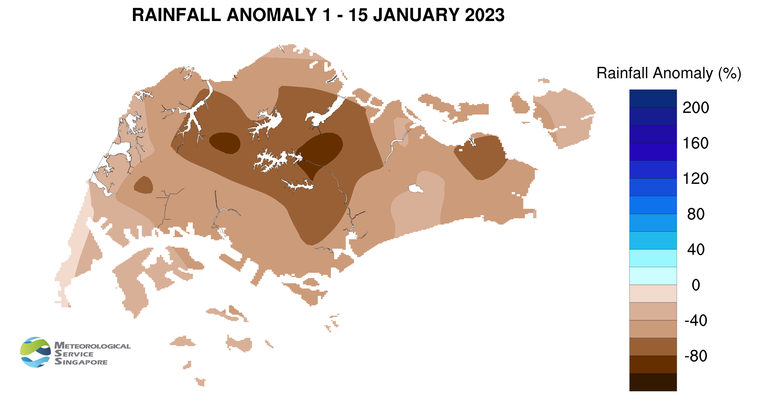Singapore, 16 January 2023 – The Northeast Monsoon conditions prevailing over the region are forecast to persist into the second half of January 2023, with low-level winds blowing from the northwest or northeast. During the Lunar New Year period, a high-pressure system over the northern Asian continent is likely to strengthen and bring wetter and cooler conditions to the region.
2 The next two weeks of January 2023 are expected to be wetter than the first fortnight of the year. Over the Lunar New Year period, a possible strengthening of a high-pressure system over the northern Asian continent could bring a surge of strong north-easterly winds (or monsoon surge[1]) over the South China Sea. The surge is likely to last for a few days and may bring cooler conditions with spells of showers over Singapore and the surrounding vicinity. The rainy weather is likely to ease in the last week of the month with localised short-duration thundery showers to be expected in the afternoon. Overall, above average rainfall can be expected for the second half of January 2023 and the total rainfall for the month is likely be near average over most parts of the island.
3 In the second half of January 2023, the daily temperature is forecast to range between 24 degrees Celsius and 32 degrees Celsius on most days, and may reach a high of 33 degrees Celsius on a few days. The rainy weather during the monsoon surge period is likely to result in lower daily temperatures of between 22 degrees Celsius and 30 degrees Celsius on a few days.
4 For updates of the daily weather forecast, please visit the MSS website (https://www.weather.gov.sg), NEA website (www.nea.gov.sg), or download the myENV app.
REVIEW (1 – 15 January 2023)
5 Northeast Monsoon conditions prevailed over Singapore and the surrounding region in the first half of January 2023. The low-level winds blew from the northwest or northeast during this period.
6 There were less showers in the first half of January 2023 compared to the second half December 2022. On several days in the first two weeks of 2023, strong solar heating of land areas coupled with localised convergence of winds brought short-duration thundery showers, mostly in the afternoon. The thundery showers that fell over many areas of the island on 15 January 2023 resulted in a daily total rainfall of 47.4mm around Bedok North area. This was the highest total rainfall in a day for the first half of January 2023.
7 It was also relatively cool in the first half of January 2023 with only two days when the daily maximum temperature was higher than 34 degrees Celsius. The highest daily maximum temperature of 34.8 degrees Celsius was recorded at Paya Lebar on 8 January 2023. In the first two weeks of 2023, the daily minimum temperature ranged between 23 degrees Celsius and 24 degrees Celsius on most days. The lowest minimum temperature recorded during the period was 22.3 degrees Celsius on 12 January 2023 at Sembawang.
8 Singapore received well below average rainfall in the first fortnight of January 2023. The highest anomaly of 90 per cent below average was recorded at Bukit Panjang. The anomaly was lowest at Chai Chee at 30 per cent below average.
[1] A monsoon surge refers to a strengthening of winds over the South China Sea, causing extensive rainclouds to form over our surrounding region. Read more at https://www.weather.gov.sg/learn_weather_systems/
CLIMATE STATION STATISTICS
Long-term Statistics for January
(Climatological reference period: 1991 – 2020)
| Average daily maximum temperature: | 30.6 °C |
| Average daily minimum temperature: | 24.3 °C |
| Average monthly temperature: | 26.8 °C |
| Average rainfall: | 221.6 mm |
| Average number of rain days: | 13 |
Historical Extremes for January
(Rainfall since 1869 and temperature since 1929)
| Highest monthly mean daily maximum temperature: | 31.8 °C (1998, 2016) |
| Lowest monthly mean daily minimum temperature: | 21.6 °C (1934) |
| Highest monthly rainfall ever recorded: | 818.6 mm (1893) |
| Lowest monthly rainfall ever recorded: | 15.4 mm (1997) |

